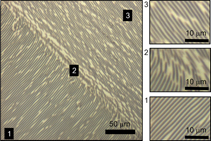Article contents
Self-organized wrinkling of liquid crystalline polymer with plasma treatment
Published online by Cambridge University Press: 05 November 2018
Abstract

Highly ordered wrinkling morphologies of liquid crystalline polymer films are demonstrated based on simple multi-rubbing. The spontaneous pattern formation of periodic wrinkling morphology is achieved through utilizing plasma treatment on a predefined alignment layer. The multi-directional ordering on the alignment layer obtained through selectively covering the alignment layer with a protective layer, which is chemically inert and keeps alignment properties during another rubbing process. The ordering of the wrinkle pattern can be tailored through a molecular orientation of liquid crystal (LC) and a process condition, including film thickness, plasma treatment, and rubbing. The proposed methods enable the spontaneous pattern formation of well-aligned one- or two-dimensionally periodic microstructures over a large area, without an additional template or patterning steps. Since the LC polymer incorporated the optical anisotropic mesogenic groups into polymer chains, it has an optical birefringence in the film and it can be utilized for optical devices requiring a microstructure on a surface.
- Type
- Invited Paper
- Information
- Copyright
- Copyright © Materials Research Society 2018
References
REFERENCES
- 4
- Cited by




